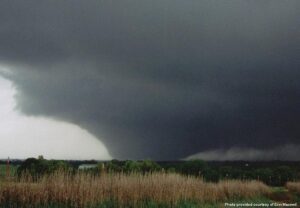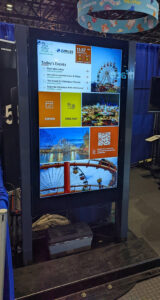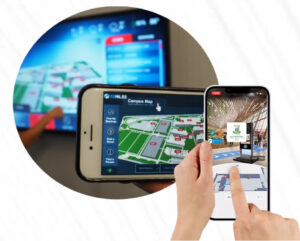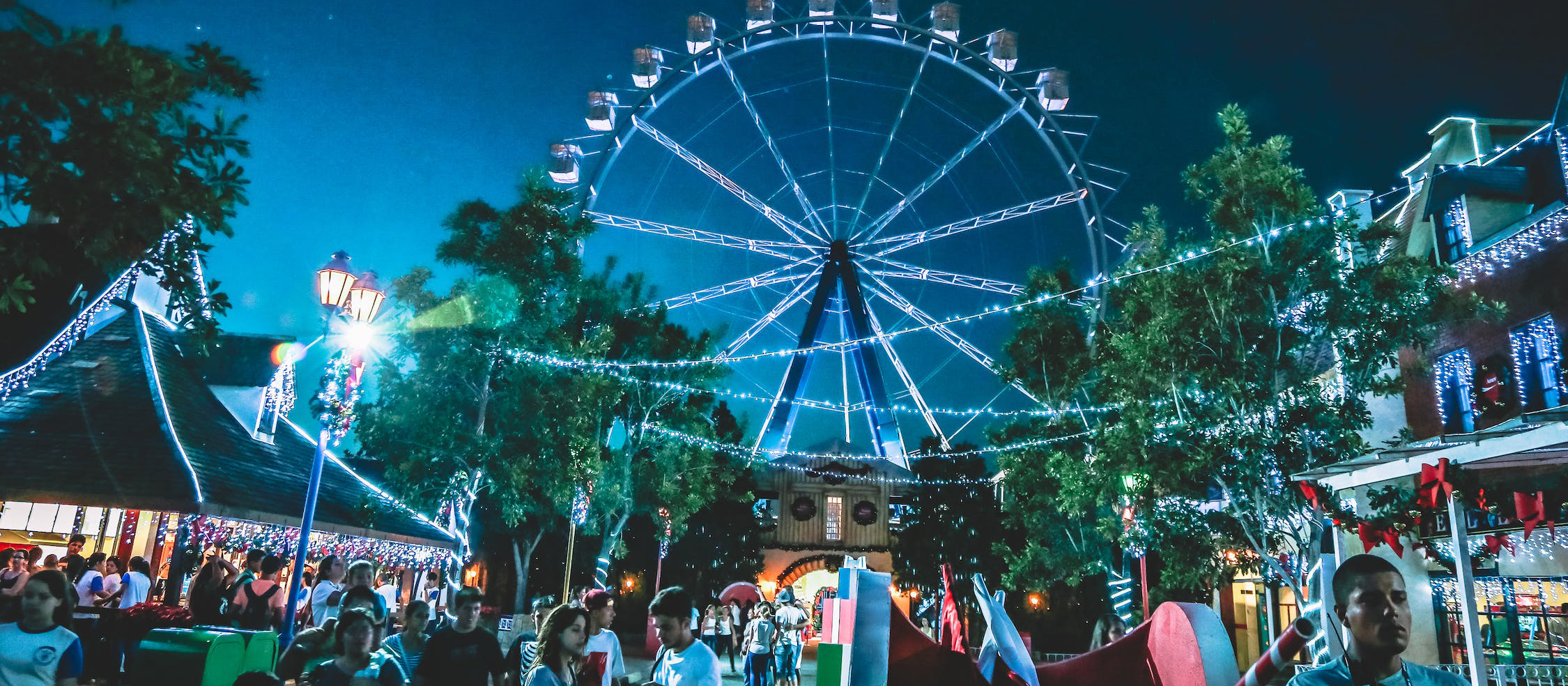Amusement parks are a great place to have fun, but they can also be overwhelming, especially for first-time visitors. With so many rides, attractions, and restaurants to choose from, it can be difficult to know where to go and what to do. This is where interactive wayfinding comes in.
Innovative rides, roller coasters, and shows have made significant strides in use of cutting edge technology but placing new interactive technology at the guest level- in front of them or in their hands while not directly on an attraction has lagged. Admittedly, the pandemic played some part in that.
Interactive wayfinding systems use touch-screen kiosks, compliment mobile apps, and other digital technologies to help guests find their way around the park. These systems can provide real-time information on ride wait times, show schedules, dining options, and more. They can also be used to create personalized itineraries based on visitors’ interests through intuitive AI technology. However, most in park management still see them simply as in-park billboards.
Strategies to make the most impactful use that transforms the expense of Wayfinders leveraging data and revenue generating possibilities never available before:
1.) Install attention-getting signage as a “welcome” at your front gate
The wayfinder software platform allows each screen to operate independently, showing content that reflects different priorities.
Create visually dynamic screens at your point of entry that highlight shows, special promotions, incoming weather, new rides and features, etc. Plan different content to display at different times of the day. Use videos/commercials to highlight general park goodwill as well as make use of QR codes for inside-the-park coupons to drive in-park/per-cap spending. Modify visual marketing strategy daily, hourly, weekly to maximize effect.
Track data on scans, interactions, etc…
2.) Plan objectives for each screen in the park to achieve specific goals.
Put your Marketing Team to work! Design promotions and benchmarks for each screen to achieve. If you just roll ads on a continuous loop with no other goal or interaction you’ve just created an expensive slideshow screen that will blend into the landscaping.
Each section of a park (or zoo) has its own rides, restaurants, games, etc. I’ve never dropped $5 to play a game in a park- so, chances are theme park “A” will never get that per cap spending from me. However, if a screen were to have a dynamic ad pop up with a special promotion and QR for: 20% off, one game for $3 or two for $5, etc.- you’ve just created an incentive for me (and others) to participate.
I have an annual pass to my “local” park. Park food is expensive. I generally eat before coming, so purchasing $50+ in a meal for my family probably won’t happen too often. However, a well placed screen putting funnel cake/cinnamon roll in front of me while walking by with a QR offering a promotion… You may make an impulse sale (or two, or three).
ALL of these promotions can be easily tracked for effectiveness and give your marketing departments achievable benchmarks to increase per cap spending.
3.) Weather Forecasts and Other Alerts
 Weather is the constant wild card in the parks and can change very quickly in the summer months- seconds if you’re located in Florida. In the midwest, late afternoon and early evening can be interrupted by Tornado Watches and Warnings. Never a positive for the parks, but a very present and persistent threat.
Weather is the constant wild card in the parks and can change very quickly in the summer months- seconds if you’re located in Florida. In the midwest, late afternoon and early evening can be interrupted by Tornado Watches and Warnings. Never a positive for the parks, but a very present and persistent threat.
Within your screen “universe” dashboard- with just a few clicks you can create a condition where every screen will have the current weather radar up as well as National Weather Service Updates and instructions to find the nearest shelter.
Other alerts like a lost child, ride operations disruption, emergency messages, etc. can be displayed.
4.) Gather Guest Communication and Other Analytics through Interactions
The walkways are the most under-utilized Guest Experience driver in a park. Some would say it is the line queue- which I’d place in a different category: lost opportunities. Most line queues have screens in them that run generic park advertisements and to a lesser extent, music videos and mindless games… that repeat every five minutes instead of being interactive, via QR scan and pointing guests to interact with the park app, website, etc. and/or displaying promotions, special pricing… or that funnel cake I wrote about earlier.
Data Delivery, Increased Per Cap spending… are you catching a recurring theme yet? Parks and Zoos view wayfinding mostly as advertisement billboards… which they can be- but that’s only a fraction of what could be.
5.) Walkway Interactive Wayfinders
Well, this one’s obvious; isn’t this what the blog is about anyway?
Unless you’re a Central Florida, Southern California, or other known resort community park, more than likely you’re a more “local” park rather than a destination park. There are some variances, but there is a lower instance of someone flying a couple thousand miles (or international) with the park being the main reason for the travel. However, in both instances, interactive Wayfinding kiosks are still relevant and can be useful for… wait for it… driving analytics and per cap spending.
For Destination Parks- wayfinding is easy. I’ve been to Orlando’s big three on many occasions. But if I had in mind to get from point A to point B I’d never be able to navigate without a map. And… I’m not going to carry a paper map with me all day, especially after it gets wet from the obligatory water ride, and sometimes the map on the App screen is too small to get “the full picture.” Plus, if I used the App as much as the features want you to- my phone’s battery is dead by noon anyway. Interactive Wayfinding Kiosks allow quick information, directions, wait times, etc… not to mention details on location-specific promotions dictated by your marketing team.
Local Parks can enhance guest experience to the “locals” who just come to the park to get their daily steps in as well. The content and priorities are different but the outcome is the same. Local population park patrons generally have season passes and, depending on the park, meal plans. They’ve usually spent their money before the season began and cash-flowed that meal plan within the first month- and let’s face it, only use your park app to scan their pass upon entry and for ride wait times. Interactive Wayfinding Screens and your marketing team give your management another tool to engage these “50-visits-per-season-but-spend-$0” guests- that in any other universe stopped spending money at your parks the day it opened for the season.
6.) Digital Ad Space Revenue
 Here’s the part where there is an exponential benefit to the “slide-show (with some video) ad space.”
Here’s the part where there is an exponential benefit to the “slide-show (with some video) ad space.”
Large destination parks can leverage broad sponsorship opportunities from vendors with a national footprint, ie- soft drink makers, ice cream vendors, as well as purveyors of fine coffee (because who doesn’t enjoy a $6, hot coffee on a 95 degree/oppressive humidity day?).
Local Parks can use this space for local sponsors, auto dealerships, hospitals, accounting firms, restaurants, etc… Some of these parks include local flavors inside their venues as well. Place an ad with a QR and call to action and –BOOM– you have increased per cap and analytics for use.
In most instances, using effective marketing, Interactive Wayfinding Kiosk projects can be monetized to become a profit center within just a couple years.
7.) Updated Technology
Many parks invested in this technology when it was new back in the 2012-2015 window with promises from Marketing firms with all sorts of outlandish features. Let’s run down those “feature”:
-
- Some were interactive, most had static content
- Glitchy software with no tie-backs to legacy park technology (or App)
- Software and technology present at installation = same for duration
- Mostly unreliable with a lot of down time
- Screens that were not visible in direct sunlight
- Screens lasted, usually, just one season- two if you were lucky
- Software repair could take days/weeks
It’s 2023 and a whole new ballgame on technology:
-
- Kiosk manufacturers offer performance warranties for a period of years (one we work with goes up to 10 years).

- Software glitches fixed remotely within minutes
- Screens warrantied to be visible in direct sun and last years.
- Kiosks built to withstand “reasonable” abuse and weather conditions. One kiosk manufacturer has a Youtube video of a screen absorbing repeated blows from a 2X4 board without missing a beat. However if hit by a truck…. The truck is probably going to win.
- Meanwhile most early screens were hyped slideshow ads with little interaction, today’s kiosks encourage interaction and track… analytics.
- Kiosk manufacturers offer performance warranties for a period of years (one we work with goes up to 10 years).
8.) Reinforce Park and Environment Theming
Most parks have multiple themed environments. Sometimes the rides reflect that, sometimes not. Interactive Screens inside that environment can be complemented with a themed cover (or shroud) that can be changed throughout the year or when the environment theme details change. Not only that but the screen content can be updated for Spring, Winter, Fall, Summer, monthly, daily… or for other special events.
It would really be the only feature in the park that could change within minutes that the change is needed at very little cost each time. Static signs in the park take days to design, + weeks to build, + more days to install. And, some municipalities need a permit to do so. Once these are installed, their content can change as fast as your marketing department can fire up PhotoShop or Premiere and click “publish.”
These are just some of the features and benefits that I could rattle off. the Attractions Group is, literally, a group of companies passionate about the attractions industry and enhancing guest experience in ways that create data-based decisions and drive increased guest per cap spending. Most park operators and management are not familiar with the benefits these kiosks offer and remain “parked” in the 2012 understanding of what they do. Today’s kiosks are software powerhouses driven by cloud technology and use AI enhancements that drive the experience.
If I’ve just described your park, zoo, or other entertainment venue- contact us for a virtual demo to see how this will drive you forward!

